Mobile users make the most of online traffic today. You can adapt to their needs by providing adaptive web solutions, but there are a benefits things that only in-app mobile experiences can guarantee.
The businesses we describe in this article understood this potential early on. Not only did they decide to make mobile the center of their business strategy, which was often seen as a bold move a in a previous decade; they also designed the user experience and used the in-app features to grant them long-term market leadership.
Dive into their success stories and get inspired! But before, let’s understand how mobile-first strategy can boost your growth.
Why a mobile app can bring you a fast ROI?
First: gathering customer insights becomes much easier with the native traffic. You can design your app to make feedbacking and advanced data analysis of purchase history an inherent part of the experience and use what you know about your users to engage them even more.
Second: mobile apps offer significantly more control over the user experience compared to mobile-adaptive websites. With app notifications, you can deliver timely, personalized content and messages that keep users engaged and informed, directly contributing to higher user satisfaction and ongoing interaction.
Third: mobile apps enhance customer retention by leveraging built-in features like push notifications, in-app rewards, and seamless navigation that support every stage of the customer journey. These tailored experiences build deeper emotional connections, reinforcing brand loyalty far more effectively than a mobile website can.
There is no all-time recipe for success in mobile – some companies leverage advanced personalization or user generated content, others spice up their PR and communication strategy, and some just focus on nailing the location based services so that users simply don’t search for any other provider.
The success stories below can give you a grasp of what can work in mobile – and how to ensure that your mobile app, its architecture and features, work in your favor long term, both in B2C and B2B.
HelloFresh – Reinventing grocery shopping through mobile meal kits
Industry: Food Tech / E-commerce / Meal Kit Delivery
Region: Europe, North America, Australia
Model: B2C (mobile-first subscription platform for home cooking and ready-to-eat meals)
How did HelloFresh turn meal kits into a mobile empire?
Ten years ago, grocery shopping meant fluorescent aisles, long queues, and forgotten shopping lists. Then came HelloFresh, slicing through the clutter with pre-portioned meal kits delivered to your door, and more importantly, to your mobile devices.
What started in Germany as a lean startup is now a global food tech giant present in 16 countries, serving millions of customers who swapped supermarket stress for digital dinner prep. The secret? A mobile-first mindset and relentless focus on user experience.
What unique consumer need did HelloFresh tap into?
Cooking at home used to feel like a chore. HelloFresh turned it into a curated experience. Their insight was sharp: people want to eat better but don’t always know how. By offering flexible, dietician-backed recipes and clear instructions, HelloFresh made healthy eating not only easier, but actually enjoyable. It’s a brand built on customer satisfaction, one dinner at a time.
Why did HelloFresh outcook its competitors? While rivals like Blue Apron stuck to traditional web flows and struggled with scalability, HelloFresh went full-throttle into mobile. That’s where own mobile apps made all the difference.
Early on, the company partnered with Miquido to dismantle its tech monolith into microservices. This wasn’t just a backend decision; it laid the groundwork for feature-focused teams operating in a Spotify squad model. That meant more agility, faster testing, and higher-quality rollouts across their mobile platform.
The result? While competitors were still debugging, HelloFresh was deploying – at scale.
How did mobile strategy boost HelloFresh’s customer loyalty?
HelloFresh created a pocket-sized sous-chef. The mobile app became a hub for recipe browsing, real-time order tracking, dietary preferences, and – crucially – push notifications. These alerts nudged users to complete orders, try new recipes, or take advantage of time-limited deals. It was the digital equivalent of a friendly reminder… without the guilt trip.
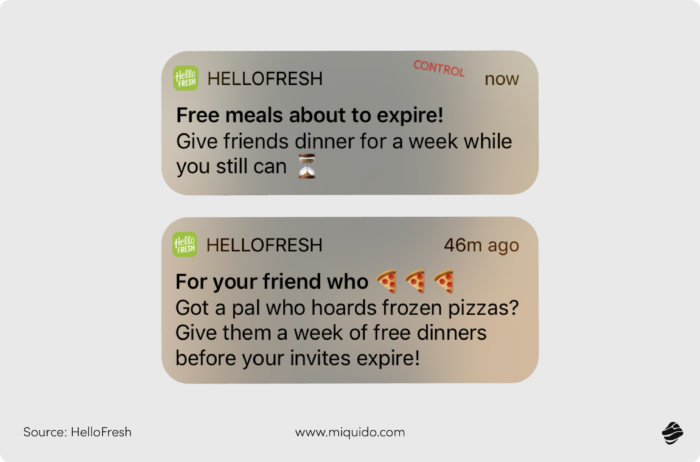
The approach worked. By Q1 2022, HelloFresh had over 8.5 million active subscribers. Even in 2023’s trickier market conditions, they held strong at over 7 million users — proof that mobile apps benefit businesses when they go beyond the basics.
What was HelloFresh’s biggest hurdle in going global?
Meal kits have one big Achilles’ heel: churn. On average, users only stick around for 4–5 months. That meant HelloFresh had to keep reinventing how they stayed relevant, not just tasty.
The solution? Keep the app sticky. From push notifications to weekly surprises, limited-edition recipes, and gamified discounts, HelloFresh layered engagement tactics to maintain customer loyalty and increase customer engagement.
Did HelloFresh use mobile marketing in unexpected ways?
Absolutely. And with flavor. One standout moment? Their appearance inside the show How I Met Your Father – not as an ad, but as part of the plot. The characters used HelloFresh kits during scenes, making it feel like a casual product placement that lived inside the story.
They also tapped into Spotify with in-app offers and leaned on influencers and podcast hosts to tell the HelloFresh story, always with a promo code ready for quick app download. It wasn’t just smart advertising; it was mobile-integrated storytelling.
What role did tech play in HelloFresh’s long-term success?
Behind every perfectly timed push notification and intuitive meal planner was a highly modular tech stack – a decision that let HelloFresh adapt at scale.
Thanks to their microservice architecture, HelloFresh could introduce new products like ready-to-eat meals (via Factor and Youfoodz) and regional grocery expansions (like HelloFresh Market) without breaking a sweat. This tech-forward approach allowed them to diversify meal occasions beyond dinner –including snacks, lunch, and breakfast – and tailor offers to match shifting user preferences.
“We built HelloFresh with e-commerce at the core of our model, surrounded by a strong team focused on operational excellence.”
— Dominik Richter, Co-founder & CEO
Why does the HelloFresh app still stand out in 2025?
Because it never settled for just being functional. The HelloFresh app is delightfully frictionless, offering meal suggestions, intuitive UI, and flexible plan management. It’s a true example of how mobile applications benefit businesses when done with care and creativity.
Today, HelloFresh isn’t just a meal kit company. It’s a mobile-first food experience, a data-driven meal planner, and a logistics powerhouse wrapped in an app. In short? They didn’t just change the way we eat. They changed the way we shop — forever.
The Meal Kit Market is valued at USD 18.5 billion in 2025. Also, this niche of the foodtech market is on track to grow at a staggering 17.1% CAGR, reaching USD 76.7 billion by 2034. That kind of momentum means there’s plenty of room for fresh ideas, even with giants like HelloFresh in the lead. As new foodtech startups emerge, they can carve out space by targeting untapped niches, innovating on delivery models, or layering in tech that the incumbents haven’t perfected yet.
Wego – dominating mobile travel in the middle East & Asia
Industry: Travel / Meta-Search Marketplace
Region: Asia-Pacific & MENA
Model: B2C (app-first travel aggregator for flights, hotels)
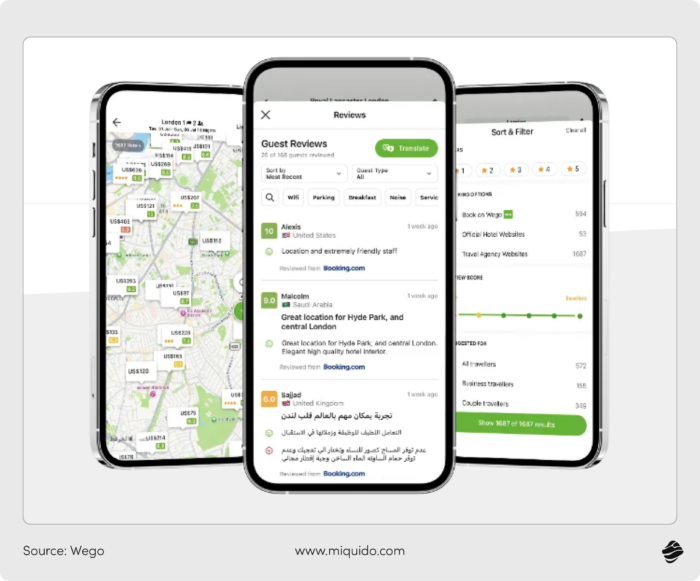
Once upon a time, booking travel meant digging through endless tabs, slow mobile websites, and dealing with clunky offline agents. Then the travel apps started appearing, and Wego joined the wave. Starting as a desktop travel search engine, Wego took a bold leap in 2014: going all-in on mobile. The result? A sleek, multilingual, lightning-fast app that now dominates travel bookings across the Middle East and Southeast Asia.
What sparked Wego’s mobile-first transformation?
Wego’s team saw what many businesses in the region missed: smartphones weren’t just a convenience, but the primary gateway to the internet. In regions like the UAE and Indonesia, customers didn’t want full-service travel sites on desktops. They needed fast, intuitive travel tools in the palm of their hands.
Wego launched a redesigned Android app rooted in Google’s Material Design, engineered to thrive on both premium devices and budget phones. Rather than just a facelift, it was a strategic rebuild to enable users across varied markets to plan and book travel with zero friction.
Why did localization give Wego the edge?
Localization wasn’t a footnote – it was the blueprint. Instead of just translating its UI, Wego reimagined the experience for each market.
In MENA, that meant Arabic-first interfaces, regional airline APIs, and currency filters tailored to local needs. For Southeast Asia, the app rolled out in Bahasa and other key languages. Even the color palette and layout shifted to reflect regional preferences.
This approach turned what could’ve been a generic app into something that felt homegrown, a powerful move in building lasting customer relationships.
What made the app experience truly stand out?
Speed, simplicity, and seamless design. Wego’s developers reengineered the app with native technologies and streamlined booking flows. The app felt fast, even on low-end Android phones. It was optimized for mobile browsers but built for the app experience.
They didn’t stop at UX polish. Wego also prioritized deep content indexing, regional deals, and a powerful meta-search engine that let users compare flights, hotels, and travel packages in seconds.
The result? A top-rated app across Meta and OTA categories, especially in high-growth markets like Kuwait and Saudi Arabia.
How did Wego outperform rivals like Cleartrip?
While Cleartrip eased into mobile with a gradual shift, Wego raced ahead with a full app-first strategy nearly a decade ago. That head start paid off.
Wego’s superior UI/UX, broader language support, and obsessive focus on speed helped it outpace Cleartrip in user acquisition and retention. By 2024, Wego was the #1 downloaded travel app in the MENA region – a feat built on early tech bets and consistent user-first thinking.
What hurdles did Wego face?
Plenty. The diverse device landscape in Asia and MENA – from budget Android phones to the latest flagships – made performance tuning critical. Supporting offline functionality wasn’t a major play, but they optimized caching to handle patchy connections and ensured the core experience ran smoothly even in 0/1–2 signal zones.
Balancing localization with complexity was another tightrope walk. Every new currency, language, or payment method added potential bloat. But Wego’s modular approach kept the app agile.
And while some competitors integrated direct booking flows, Wego stuck to its meta-search model, giving users choice and keeping business relationships with travel partners intact.
Why is Wego still winning in 2025?
Because they never stopped iterating. From monthly A/B testing to UI refreshes aligned with Android guidelines, the Wego team kept the app feeling fresh and frictionless.
Even now, Wego continues to lead in download growth, with 305,775 downloads in May 2024 alone (+44% YoY). It’s a shining example of how mobile websites and mobile browsers can support a product, but a native app, when done right, becomes the hero.

Too Good To Go – Scaling the zero-waste movement through mobile and PR
Industry: Food Tech / Sustainability
Region: Europe → North America, Australia
Model: B2C (food surplus marketplace via app)
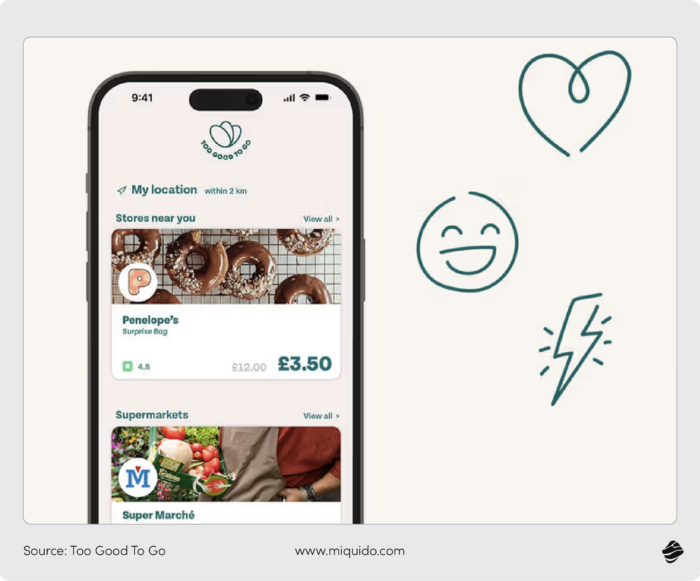
Too Good To Go is a quiet revolution that starts with a tap. Launched in Denmark, it transformed local sustainability from a good intention into a mobile habit. Where mobile websites once dominated, TGTG’s mobile platform made it easier and more delightful to rescue food before it’s tossed.
Their well designed mobile app didn’t just display leftover pastries – it wrapped them in mystery, calling them “Magic Bags.” That clever UX twist, delivered through a mobile app that serves both speed and simplicity, gave the brand its viral spark.
How did TGTG turn waste into wonder through mobile?
Rather than overload users with features, the team focused on simplicity: geo-located surplus food, a clean UI, and pickup windows that fit daily routines. This wasn’t just mobile-first – it was mobile-crafted. The app remains accessible across a wide range of devices and works even on spotty internet connection, supporting areas where offline performance is crucial.
Their mobile loyalty programs rewarded habitual rescuers, and the subtle gamification kept momentum. With push notifications gently reminding you to “save dinner and the planet,” the mobile app served more than food – it served purpose.
What fueled its growth across borders?
A mobile-first mindset was only half the magic. The other half was narrative. From the start, the team invested heavily in PR, telling stories that resonated with their eco-conscious target audience. This strategy turned users into ambassadors and every media article into free marketing.
- Over 100M users globally by 2025
- 175,000+ businesses onboarded
- More than 400 million meals saved
- Brand awareness skyrocketed to 54% in key regions
How did they enhance customer engagement without paid ads?
Too Good To Go’s content and push strategy were built for organic lift. Their loyalty programs weren’t only about discounts but about shared identity, being part of a mission. Users got mobile reminders about nearby rescues, and local businesses were spotlighted in-app to personalize the journey.
Where many apps chase attention, TGTG cultivated intention. The app became a badge of pride – your proof of caring.
What made the app model scalable?
Unlike P2P food-sharing platforms that depended on volunteers, Too Good To Go chose a mobile platform that businesses could plug into easily. Retailers updated their surplus stock in real time, users booked pickups within the app, and everything, from payments to push notifications, flowed through the app’s intuitive infrastructure.
The decision to create mobile apps tailored to retail food rescue made all the difference. Unlike clunky mobile websites, their own app ensured consistent UX and performance across global markets.
Challenges on the way
- Localizing logistics across countries, languages, and regulations
- Managing internet connection and syncing stock in real-time
- Convincing retailers to trust a “surprise bag” concept
- Keeping the mission clear while optimizing app retention
✅ Summary Table
| Metric | Value |
|---|---|
| App Launch | 2016 (Denmark) |
| Global Users (2023) | 62M+ |
| Meals Saved | 200M+ |
| Partners | 164,000+ |
| Mobile Strategy | Local discovery + push + simplicity |
| Key Growth Lever | Mobile-first PR + loyalty programs |
| Top Quote | “An easy, local way to make a difference.” |
Too Good To Go mastered the art of scaling sustainability through mobile. Its own app, refined loyalty programs, and emotionally resonant messaging didn’t just capture users, but also mobilized them. For markets overwhelmed by mobile websites and underwhelmed by impact, this app offered clarity, community, and contribution.
“With so much media buzz… it wasn’t difficult to build up reach among users on Instagram and Facebook… Our channels became exciting for our potential partners too.”
– Florian Schleicher, Marketing Lead
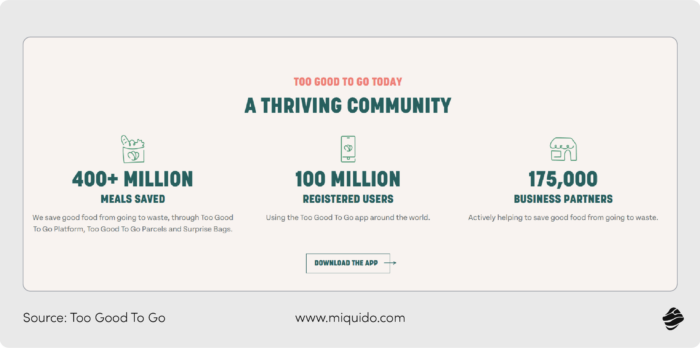
PicPay – Brazil’s mobile-first fintech giant
Industry: Fintech / Digital Wallets / Mobile Banking
Model: B2C + B2B (wallet + banking + acquiring + credit)
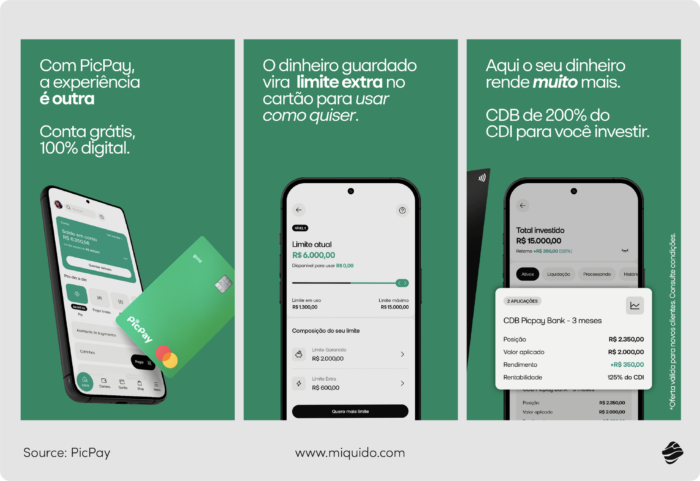
In 2012, sending money in Brazil meant bank queues, paperwork, and a whole lot of friction. PicPay, a mobile-first disruptor, asked a simple question: what if paying someone was as easy as texting?
With a sleek app, QR-based payments, and a bold bet on Brazil’s smartphone revolution, PicPay rewrote the rulebook for digital finance, long before the rest of the market caught on.
What made PicPay’s early strategy so smart?
They skipped the desktop era entirely. While many businesses were still adapting their services to mobile browsers or offering clunky hybrids, PicPay launched as a pure mobile play.
Their 2012 MVP offered QR payments between users – a concept that seemed futuristic in a country where cash still reigned supreme. But as smartphones became Brazil’s default device (used by over 85% of internet users), PicPay’s head start turned into dominance.
How did PicPay evolve into a fintech super-app?
By layering value – smartly. Over the years, PicPay added:
- Digital wallets and instant transfers
- Bill payments and prepaid savings “cofrinhos”
- Loans (including payroll loans via BX Blue)
- Credit cards, cashback, and AI-powered financial insights
All delivered in one app, all mobile-native. The app didn’t just function offline in select cases. It became the central financial hub for tens of millions.
Where many businesses try to bolt new features onto legacy systems, PicPay’s super-app design was unified from day one, enabling users to manage every aspect of their money without ever switching platforms.
What gave PicPay a competitive edge over rivals like Nubank and Mercado Pago? Nubank nailed digital credit cards. Mercado Pago conquered e-commerce, but PicPay won in everyday life.
It wasn’t tied to a specific platform (like Mercado Libre) or limited to banking (like Nubank). Instead, PicPay positioned itself as Brazil’s most open and accessible financial platform for consumers, merchants, and small businesses.
With over 10 million business clients, PicPay became embedded in the very fabric of Brazil’s payment landscape. That dual-channel strategy gave it unmatched flexibility and reach.
Did tech innovation play a role in its rise?
Absolutely. From AI-powered customer support (boosting Net Promoter Score by 45%) to personalized financial recommendations that improved service usage by 3.2%, PicPay consistently pushed the boundaries of what a financial app could do.
They also built their own acquiring platform — gaining 1% market share in a hyper-competitive space. And while mobile websites and mobile browsers supported early user acquisition, the native app was where real engagement happened.
Behind the scenes, PicPay’s tech stack was battle-tested to handle everything from micro-loans to real-time cashback, even in volatile economic conditions.
What challenges did PicPay have to overcome?
In 2012, Brazil had low smartphone penetration, deep-rooted mistrust in digital banking, and limited support for QR-based systems. But PicPay stayed the course, building trust through transparent UI, clear onboarding, and easy access to support.
As the app grew, scaling merchant tools became critical. Building QR reader adoption, onboarding offline businesses, and navigating Brazil’s strict financial regulations were major hurdles. Yet, PicPay managed it all without compromising its mobile-first DNA.
Why does PicPay still lead in 2025?
Because it never stopped innovating. PicPay reached profitability in 2023, processed skyrocketing transaction volumes, and now serves over 30 million active users. By 2025, the company reported 60 million total users, R$5.6 billion net revenue in 2024, eight-fold profitability improvement. And it didn’t just grow for growth’s sake – it built real, lasting customer relationships through consistent, personalized mobile engagement.
Even in Brazil’s high-debt culture – where over 76% of households carry consumer credit – PicPay remained a trusted tool. From rent payments to tiny installment purchases (“parcelado”), the app fit seamlessly into the rhythms of everyday life.
In short: PicPay wasn’t just Brazil’s first mobile wallet. It became its most indispensable one.
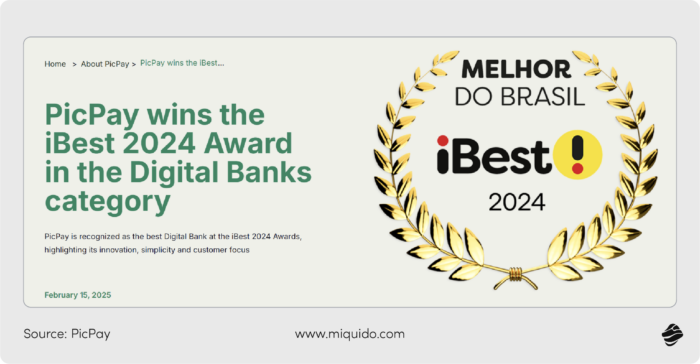
Skyscanner – Pioneering mobile to become the global travel search benchmark
Industry: Travel & Mobility Search (Flights, Hotels, Cars)
Model: B2C + B2B (Meta search + direct bookings + partner solutions)
Juggling browser tabs, slow load times, and waiting for email confirmations? That’s what planning your travel often meant just a decade ago. Skyscanner arrived with a clear mission: bring effortless global travel search to your fingertips.
Back in 2011, when most of the industry still banked on desktop dominance, Skyscanner was busy launching its first iOS app. That early leap into mobile future proofed the company and put it miles ahead of competitors.
Why did Skyscanner bet early on mobile?
Skyscanner’s team understood that mobile was more than a platform. It was a behavioral shift. People didn’t want to wait to plan trips – they wanted to search on the go, compare prices in real-time, and even book from their couch.
That early insight led to a decade-long mobile-first evolution, from a flight-only app to a full travel super-app. Along the way, it brought in powerful mobile features: hotel and car rental integration, AI tools, and even mobile-only booking flows.
In emerging markets, Skyscanner’s offline capability and lightweight performance helped the app reach millions with limited internet access. The result? Over 110 million monthly users in 2024, with 60% engaging via mobile.
What made the app experience stand out?
Skyscanner did more than creating another branded app – it engineered a tool that felt purpose-built for travelers. Whether browsing for last-minute deals or planning a multi-stop adventure, users got intuitive city pickers, location-based availability, and fast checkouts.
It also took full advantage of device features, from GPS to camera integrations for scanning documents, and even offline trip details. The key was to improve customer engagement at every touchpoint.
And while competitors like Kayak and CheapOair lagged behind with web-first experiences and redirects, Skyscanner leaned into mobile commerce early, even offering mobile-only flight sales in regions like Australia and Singapore.
How did the car rental feature change the game?
Adding car rentals might seem like a minor update, but for Skyscanner, it was transformative. Partnering with Miquido, they launched a mobile-first car rental module that mimicked the speed and polish of their flight tools.
The result? 1 million+ new users and a major uptick in conversion. By streamlining checkout, tapping into geolocation, and matching UI patterns across services, they made sure customers didn’t need to relearn the flow every time they added a new leg to their journey.
How does Skyscanner outperform the competition?
Early adoption of mobile wasn’t the only win. Skyscanner also brought in over 1,200 B2B partners by 2023, thanks to APIs and mobile tools that enable businesses to plug into its data-rich ecosystem.
Meanwhile, it embraced an “inspiration-first” approach – with over 56% of users opening the app without a set destination. That’s powerful user engagement, built not just on price comparisons but on curiosity, ease, and trust.
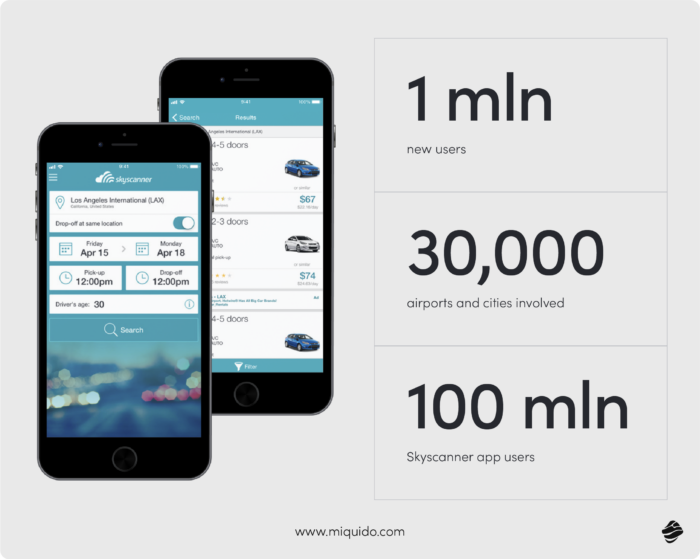
Why is Skyscanner still a travel leader in 2025?
Because it didn’t stop at just being functional. It layered in personalization, added offline capability for flight itineraries, and made the app a digital concierge – with alerts, travel tips, and seamless rebooking tools.
With over a billion searches a month and top-flight recognition in Europe, Skyscanner is more than a travel search engine. It’s a branded app that changed how the world plans, books, and dreams about travel.

Gojek – From Jakarta gridlock to Southeast Asia’s mobile super app
Industry: Mobility, Food Tech, Fintech, Advertising
Region: Indonesia → Southeast Asia
Model: B2C + B2B (rides, food delivery, payments, merchant tools, ads)
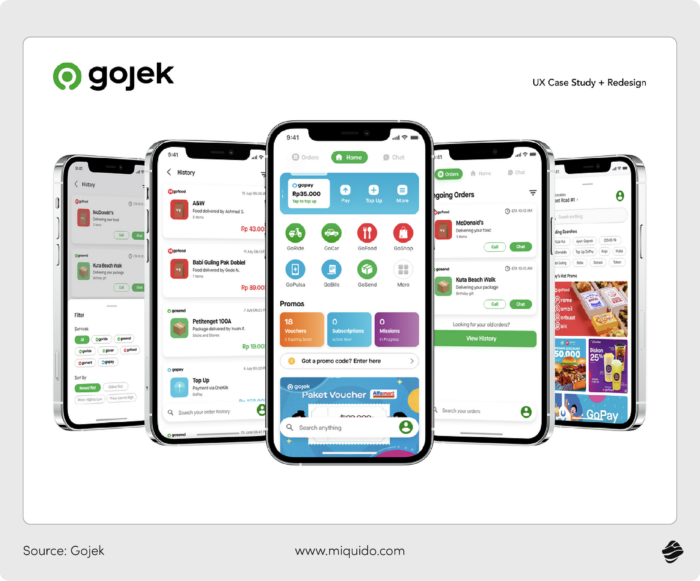
Jakarta gridlock wasn’t just a nuisance – it was the spark for one of Southeast Asia’s most revolutionary startups. Born out of chaotic commutes, Gojek turned the humble motorcycle taxi into a digital force that now powers rides, food, payments, and more for millions.
And the secret sauce? A relentless focus on mobile-first strategy, built around local realities.
How did Gojek ride mobile into explosive growth?
In 2015, Gojek shifted from call center to app, and suddenly, everything changed. With a few taps, users could book a ride, order food, pay bills, and track deliveries, all within a single super app. That rapid expansion, fueled by mobile UX designed for low-end phones, created a platform that didn’t just meet demand – it created it.
The app didn’t rely on mobile browsers or half-hearted hybrids. It was built for smartphones from the ground up, lean, fast, and localized. That helped Gojek reach over 30 million downloads in under two years.
What role did mobile payments play?
Massive. In a country where over half the population was underbanked, Gojek’s GoPay became a real financial lifeline rather than just a wallet. Users could pay for food, rides, and retail goods without needing a bank account. Merchants could join the digital economy with zero friction. This kind of inclusive tech didn’t just improve customer engagement – it enabled businesses to thrive.
Gojek even layered in microloans, QR payments, and cashback offers, making GoPay one of the most-used e-wallets in Indonesia.
How did Gojek support businesses beyond consumers?
While many super apps chase users, Gojek built for merchants too. Its mobile-first design empowered SMEs to receive orders, launch ads, and track revenue directly from their phones.
Even major brands like McDonald’s ran successful social media channel integrations and programmatic ads via Gojek’s ad network – complete with offline DOOH screens on motorcycles. The Prosperity Burger campaign in 2020? It delivered a staggering 2,638% ROAS improvement, proving that Gojek wasn’t just a platform. It was a marketing engine for the real world.
How did Gojek tackle its biggest hurdles?
Fragmented regulations? They built local teams. UX overload? They introduced micro-apps within the platform. Limited banking access? GoPay bridged the gap.
They even integrated offline capability, helping users complete transactions in areas with poor connectivity, critical for mobile-first economies. Gojek turned every obstacle into an opportunity, growing to 2.6 million+ active drivers and contributing 2% of Indonesia’s $1 trillion GDP.
What makes Gojek a case study in mobile mastery?
Because it didn’t just digitize services. It reimagined daily life.
By combining device features like location tracking and push alerts with hyperlocal service design, Gojek created a unified experience, from food stalls to multinational chains.
It’s not just a super app. It’s a national infrastructure, built on the back of smartphones and powered by deep local insight.
TUI Group – Rapid mobile acceleration drives travel giant’s rebound and growth
Industry: Travel & Tourism (Europe, Global)
Model: B2C (Direct bookings, excursions, ancillaries)
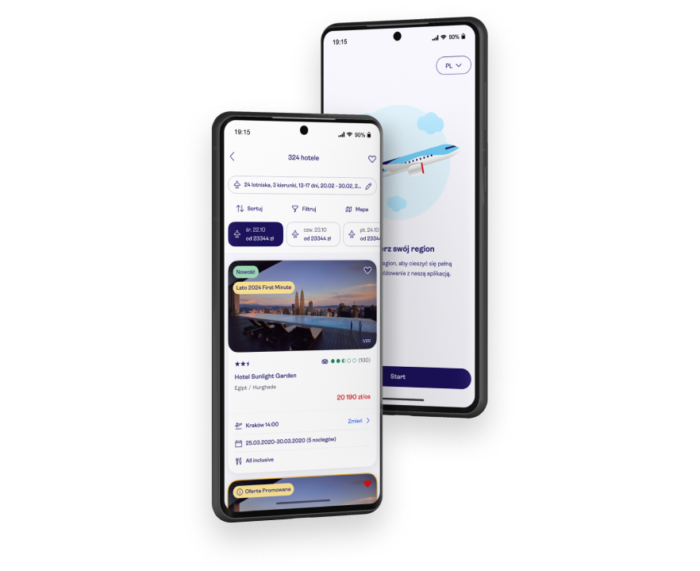
For decades, TUI was known for brick-and-mortar agencies, travel brochures, and seasonal deals. But as the travel landscape changed, so did they, radically. Today, TUI is a mobile-first giant, with a reimagined app that doesn’t just support bookings – it drives them.
What triggered TUI’s mobile transformation?
The shift began in 2013 with a simple mobile tool. But it wasn’t until recent years that the company turned its app into the centerpiece of its strategy.
From secure payments and AI-powered travel planning to in-destination updates and real-time booking flows, TUI’s app became a branded app users rely on – not just before their trip, but during and after.
By 2025, 78% of TUI holidays were booked via mobile, with ancillary sales like excursions and insurance up by 205%. This wasn’t just tech adoption. It was a redefinition of customer experience.
How did partnerships accelerate the shift?
Miquido helped build a mobile experience tailored for the Polish market, fast, localized, and optimized for offline capability in remote destinations. Features like myTUI profiles, saved preferences, and real-time updates helped TUI improve customer engagement by making planning feel personal and frictionless.
Globally, Braze powered in-app messaging, CRM, and mobile engagement across 8 countries, creating a digital concierge that delivered upsells, travel tips, and dynamic content.
What separated TUI from legacy players?
While rivals like Thomas Cook focused on web and call-center flows, TUI’s app leapfrogged with features like:
- In-app OpenAI-powered trip planning
- Mobile boarding passes
- Secure payments via PayU
- Live chat and support beyond phone calls
- Personalized booking prompts based on past behavior
And unlike fragmented apps in the DER Touristik group, TUI’s unified platform gave it the scale and flexibility to increase customer satisfaction across markets.
What challenges did TUI overcome?
Legacy systems and regional fragmentation posed huge barriers. But TUI rebuilt core infrastructure, retrained teams on AI features, and launched real-time personalization across languages and currencies.
The investment paid off. TUI posted €3.71B in Q2 2025 revenue (+1.5% YoY), reaffirmed 10% EBIT growth targets, and saw a 118% increase in customer conversions via the app.
Why is TUI a leader in mobile travel today?
Because it embraced change early, and went all in.
On top of that, TUI’s app isn’t just a booking tool. It’s a travel companion, a marketing engine, and a dynamic commerce platform. By harnessing device features, cross-channel messaging, and intelligent automation, TUI created a mobile ecosystem that brings many benefits to users and enables businesses – from tour operators to transportation vendors – to thrive.
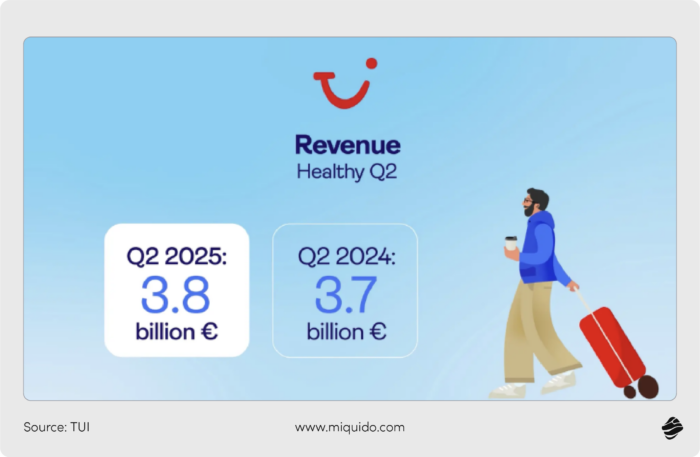
Find your own path – mobile is only the beginning
The cases we’ve highlighted offer a valuable benchmark, showcasing different angles of success, from GPS functionality to exclusive features, stronger brand presence, and improved conversion rates. While each solution delivered numerous benefits, from higher repeat purchases to better brand recognition and smoother online store experiences, they also reflect how diverse strategies can be when shaped around the needs of specific customers and business goals.
There’s no one-size-fits-all answer. What creates a competitive advantage for one brand might not work for another, especially in a dynamic industry like foodtech. Whether you’re exploring augmented reality, building loyalty through app-exclusive offers, or expanding into B2B services, the key is aligning your product with real user needs and current market demands.

![[header] benefits of mobile apps for business growth min](https://www.miquido.com/wp-content/uploads/2025/08/header-benefits-of-mobile-apps-for-business-growth-min.jpg)

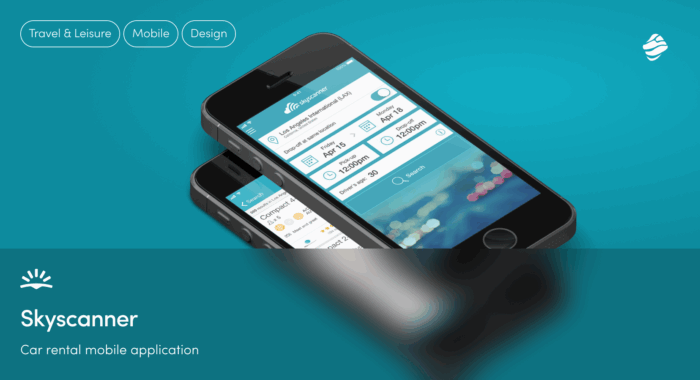


![[header] benefits of mobile apps for business growth min](https://www.miquido.com/wp-content/uploads/2025/08/header-benefits-of-mobile-apps-for-business-growth-min-432x288.jpg)
![[header] enhancing accessibility in flutter min](https://www.miquido.com/wp-content/uploads/2025/08/header-enhancing-accessibility-in-flutter-min-432x288.jpg)


![[header] why the flutter fintech app is transforming finance min](https://www.miquido.com/wp-content/uploads/2023/01/header-why-the-flutter-fintech-app-is-transforming-finance_-min-432x288.jpg)

